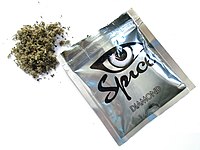
Photo from wikipedia
Abstract Synthetic cannabinoids (SCs) first emerged on the market in head shops in the form of herbal mixtures, and quickly triggered an effort to reclassify them as controlled substances. More… Click to show full abstract
Abstract Synthetic cannabinoids (SCs) first emerged on the market in head shops in the form of herbal mixtures, and quickly triggered an effort to reclassify them as controlled substances. More recently, with the increased popularity of vaping, new formulations of SCs have emerged. SCs are being dissolved or suspended in e-cigarette liquids and sold as “e-Liquids”. Furthermore, suppliers of SCs on impregnated paper sheets have been found on the black market. This could facilitate smuggling of SCs into prisons, exacerbating the problems SCs already create in prisons. The advent of such New Psychoactive Substance formulations/“new drug-delivery” systems pose a new issue for the detection and control of SCs. This work investigated various SC formulations, including e-cigarette liquids, bulk powder street samples and a set of blank A4 blotting papers believed to be impregnated with SCs to determine qualitatively their drug content. HPLC-DAD, HRMS, NMR and GC–MS provided conclusive structural identification and characterization of a number of different SCs in such alternative forms. Mass- and UV-triggered semipreparative LC-DAD-MS was successfully employed to purify SCs at a mg scale, facilitating their structural identification via NMR, and also paving the way for rapidly obtaining pure SC standards from commercial formulations. Finally, an authentic letter seized from a prison was also analysed and the two synthetic cannabinoids AMB-FUBINACA and MMB-CHMICA were detected. Our data further highlight recent reports about emerging trends which include applying SCs in alternative formulations (i.e. impregnated paper letters and e-liquids) and provide a database to help others identify these potentially toxic substances.
Journal Title: Forensic Chemistry
Year Published: 2020
Link to full text (if available)
Share on Social Media: Sign Up to like & get
recommendations!